Professional Courses
Industry-relevant training in Business, Technology, and Design
Categories
Interactive Games
Fun games to boost memory, math, typing, and English skills
Typing
Memory
Math
English Adventures
Knowledge
What is a Good Score in JEE Main for Top Colleges?

What is a Good Score in JEE Main for Top Colleges?
A good score in JEE Main is more than just a number; it's your ticket to top engineering colleges and can shape your entire future. The right marks open doors to prestigious NITs, IIITs, GFTIs, and well-regarded state universities. What qualifies as a "good score" depends on several factors, including your category, chosen branch, the overall performance of candidates in your exam session, and yearly cut-off trends. In this detailed guide, we will break it all down. You will learn what scores correspond to top colleges, how percentiles and ranks work, how cut-offs vary by category, and why a smart preparation companion like AllRounder.ai is essential.
Understanding Raw Score, Percentile, and Rank
First, let’s clarify the basics. Your raw score is what you earn in Physics, Chemistry, and Maths. You get four marks for each correct multiple-choice question (MCQ) and lose one mark for a wrong answer. The numerical answer questions (NAQs) award four marks for a correct answer with no negative marking.
While your raw marks are useful, your percentile and rank ultimately determine college entry. Your percentile indicates your performance relative to other candidates in your specific session. A 95 percentile means you scored as well as or better than 95 percent of the students in that session. Raw marks can vary by session, but the percentile system makes the comparison fair.
Once all sessions are complete, the NTA normalizes these percentiles for all candidates. This joint performance decides your All India Rank (AIR), which is the actual number used for JoSAA counselling and college admissions.
How the Percentile is Calculated
The NTA uses a session-wise method for calculation. For example, if 100,000 candidates appeared in your session and 95,000 scored equal to or less than you, your percentile is 95.0. The top scorer in that session will have a percentile of 100. This normalization is necessary because the question paper's difficulty can vary from one day to the next. You could score higher marks in an easy session than someone who appeared on a difficult day, but both could get a similar percentile if they outperformed the same percentage of candidates.
Finally, the NTA merges the percentiles across all sessions to generate a fair national rank. This ensures you are not advantaged or disadvantaged by your session's difficulty level.
Why Percentile and Rank Matter for Top Colleges
Top colleges rely heavily on percentile and rank rather than raw marks. This system allows them to treat candidates from all sessions equally. If your percentile is above a certain cut-off, you are eligible for admission. Your rank then determines the seat allocation order. The higher your percentile, the better your rank—and a better rank significantly improves your chances at top institutions.
Setting a Good Score Benchmark
What constitutes a "good score" in JEE Main varies based on your target institution. For top-tier NITs like NIT Trichy or NIT Warangal, a percentile above 98 is often required. Premier institutions like IIIT Hyderabad often expect a 98 to 99.5 percentile. GFTIs and second-tier colleges may require a 90 to 98 percentile.
Your raw marks for those percentiles can range accordingly:
- 98 to 99 percentile usually corresponds to 180 marks and above.
- 95 to 98 percentile typically falls between 160 to 180 marks.
- 90 to 95 percentile maps to 140 to 160 marks.
- 80 to 90 percentile suggests 120 to 140 marks.
These ranges are estimates based on past trends and can vary slightly each year. However, you can use this framework to target the score your chosen colleges are likely to expect.
Why Categories Change Good Score Expectations
India has reservation policies for OBC, SC, ST, and EWS categories, which means their cut-offs are lower than those for the General category. For instance, OBC cut-offs can be 2 to 4 percentile points lower, while SC/ST cut-offs may be 10 to 20 percentile points lower. An OBC candidate with a 95 percentile might secure a rank that a General category candidate would need a 97 or 98 percentile to achieve.
If you belong to one of these categories, your target percentile can be adjusted. However, aiming for the highest possible score is always the best strategy, as it makes you a strong candidate regardless of category.
Deep Dive into Top NITs and IIITs Cut-offs
When we talk about top colleges, the first names that come to mind are NIT Trichy, NIT Warangal, and IIIT Hyderabad, especially for CS or ECE branches. The closing ranks for these colleges give us an understanding of the expected percentiles.
NIT Trichy (CSE) This branch is known for its highly competitive cut-offs. In a recent year, the closing rank for Computer Science was near 1,000 to 4,000 for General category students. This usually corresponds to a 99 to 99.3 percentile. A raw score of 190+ is often necessary to secure a position.
IIIT Hyderabad This college uses the JEE Main rank for initial eligibility before candidates take its own entrance test. Historically, they expect a minimum of 98 to 99 percentile. Candidates with a top 2,000 to 10,000 All India Rank are frequently shortlisted.
NIT Warangal (ECE) The closing ranks here typically fall between 3,000 and 7,000. The percentile range is usually 98 to 98.5, meaning marks around 180 to 185 are often sufficient.
You can track these data points every year as JoSAA releases opening and closing rank trends, which helps in setting a realistic target.
Understanding Mid-Tier NITs and IIITs
The next group of colleges, including NIT Surathkal, NIT Calicut, and NIT Rourkela, require slightly lower percentiles. For these, you may find the closing rank for CS around 10,000 to 20,000, which corresponds to a 96 to 98 percentile.
Even other branches in these NITs might have cut-offs in the 90 to 95 percentile range. For certain IIITs like IIIT Bhubaneswar and IIIT Allahabad, the threshold remains similar at 96 to 98 percentile. What counts as a "good" score here depends on whether you are targeting top branches or are flexible with other streams.
GFTIs, State, and Private Colleges
Many Government Funded Technical Institutes (GFTIs) and other colleges use the JEE Main score for admissions. GFTIs like BIT Mesra and Jamia Millia Islamia often require a 90 to 95 percentile. Some may have lower cut-offs of 85 to 90 percentile. This percentile range means scoring 140 to 160 marks, but this can vary each year.
Private and state-run institutions also admit students based on JEE Main, with cut-offs ranging from 80 to 90 percentile or even lower, based on reservations and merit. This means securing a 90 percentile or above still gives you access to good technical institutes with promising placements.
Branch-Specific Cut-offs and Score Expectations
JEE Main cut-offs vary greatly by branch. Computer Science (CS) is almost always the most competitive. Scoring above 180 is crucial for this branch, even in mid-tier NITs. On the other hand, core engineering branches like Electrical, Mechanical, Civil, and Chemical often accept slightly lower percentile ranges.
For Electrical branches, a 97 to 98 percentile may be enough to secure a seat in good NITs. For Mechanical, a 90 to 96 percentile may still be sufficient. Even lower percentiles can get you into state universities or GFTIs, depending on your preference. The bottom line is to base your target score on branch competitiveness as well as college reputation.
Why Percentile Targets Change Year to Year
Two main factors change the percentile-to-raw-score mapping each year:
- Exam Difficulty: A more difficult paper lowers the raw marks required for the same percentile.
- Candidate Performance: When a large number of students score high, it pushes the percentile higher for the same raw score.
These factors mean that a score of 150 in one year might equal a 90 percentile, while the next year it could be a 95 percentile if the paper was easier. That is why analyzing data from each session is crucial.
How to Track and Predict Your Rank
Several online rank predictors use your estimated raw score to show a probable rank range. However, since results vary, it is best to rely on your official percentile or mock test trends.
This is where platforms like AllRounder.ai become invaluable. Their mock tests show your percentile equivalence and estimated rank. By taking a series of mocks, your performance trend will indicate your likely percentile. This guidance helps you set realistic targets and reorient your preparation.
Developing a Good Score Strategy
A smart approach will help you reach your target percentile.
Start Early Begin by building conceptual clarity. Use NCERT and standard textbooks to build a strong foundation in Class 11 itself.
Focus on High-Impact Topics As you near the exam, focus on high-weightage chapters. These include calculus, coordinate geometry, mechanics, and physical chemistry, as they frequently contribute the most marks.
Practice Daily and Take Mocks Practice daily by solving mixed problem sets. Follow up your content learning with weekly full-length mock tests and use monthly analysis to refine your strategy.
Improve Accuracy Analyze your error log on platforms like AllRounder.ai. Frequent analysis helps you reduce silly mistakes. Minimizing negative marking significantly boosts your raw score and percentile.
Use the Two-Attempt Approach If you utilize both JEE Main sessions effectively, you double your chances. You can aim for a solid score in the first attempt and focus on improving in the second. Your best percentile of the two attempts will be considered for your final rank.
Time Management for Maximum Score
Scoring high isn't just about knowledge; it's also about managing your time effectively. During mocks, build a consistent pace:
- Spend about 60 seconds per easy problem.
- Use 2 to 3 minutes for medium-difficulty problems.
- Attempt hard problems only after completing the easier ones.
Practice this split to avoid panic. Keep a rough timer or use the built-in analytics on AllRounder.ai.
Psychological Tips for Staying Sharp
High goals can bring pressure. To stay calm and focused:
- Follow a balanced routine.
- Exercise and meditate to maintain focus.
- Talk to mentors or peers when you feel stuck.
- Allow for full rest days to recharge.
- Celebrate your mock test wins in a healthy way to build momentum.
Psychological strength is key to staying calm during the actual examination.
Counselling and College Choices
After the exam, you will receive your final percentile and rank. At that point, use your rank to shortlist colleges and branches during JoSAA counselling. You can expect to get into colleges based on their closing rank data. If your rank falls within a college's closing rank range, you will likely be allotted that seat.
Tools like the college predictor on AllRounder.ai can help you estimate your college chances based on your final scores.
Final Recap of What a Good Score Means
Let's wrap this up:
- NIT Trichy (CSE) needs a 99+ percentile (raw score >190).
- Premier NITs often require a 98+ percentile.
- Mid-tier NITs and IIITs need a 95 to 98 percentile.
- GFTIs and some private colleges accept a 90 to 95 percentile.
Targeting raw marks of 180+ for top-tier institutes and 160+ for mid-tier ones is a good strategy. Simultaneously, using AllRounder.ai ensures your strategy is on point and your performance stays on track.
How AllRounder.ai Helps You Reach Good Scores
AllRounder.ai offers a suite of tools for your preparation journey:
- Chapter-wise quizzes for building conceptual accuracy.
- Full mock tests that mirror the real exam pattern.
- Performance tracking to analyze your mistakes.
- Spaced revision modules to support formula retention.
- College predictor tools to align your mock performance with real college cut-offs.
The platform can support you at every stage, from early preparation to results and admissions.
Final Thoughts
A good score in JEE Main is a marker of your readiness for a top institution. It depends on your category, branch preference, and yearly exam trends. Scoring 180+ is a strong start for premier institutes. A score of 160 to 175 keeps you in the running for many good colleges, while scores above 140 can open up options in GFTIs and state engineering colleges.
Your path to these scores is clear: strong fundamentals, regular practice, deep revision, and consistent mock tests. By adding in smart analytics every step of the way with a platform like AllRounder.ai, you can maintain clarity and confidence. Approach each topic with intent, each mock with purpose, and every mistake with resolve.
Keep going! You are closer than you think. With a good strategy and steady preparation, your score can be exactly what you need to secure a top college seat.

Learn how negative marking works in JEE Main 2025 and how to avoid it with practical, proven strategies.

Learn how to prepare for JEE Main 2025 with a proven, winning strategy. Get a detailed plan, subject-wise tips, and...

Learn the chapter-wise weightage for JEE Main 2025 across Physics, Chemistry, and Maths. Prioritise smartly and...

Discover the most important chapters for JEE Main 2025 across Physics, Chemistry, and Maths. Focus your prep smartly...

Discover top JEE Main books for Physics, Chemistry & Maths. Learn how NCERT & reference books pair with AllRounder.
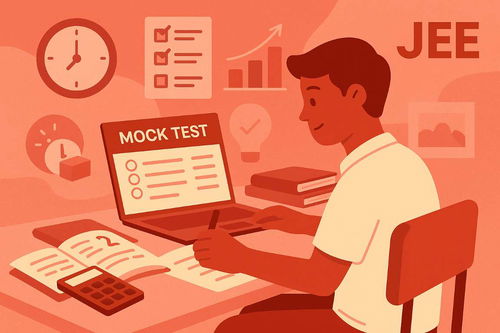
Looking for free JEE Main mock tests to boost your preparation? Discover the best platforms, tips, and strategies to...

Discover what scores and percentiles are needed to secure seats in top NITs, IIITs, and GFTIs. Learn how category...
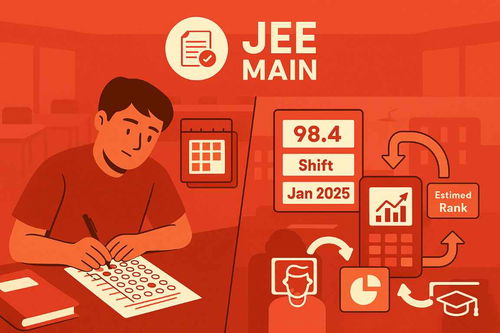
Understand the exact difference between JEE Main percentile and rank. Learn how scores are normalized across...

Understand the JEE Main scoring system to maximize your result. Learn the marking scheme, how to handle negative...

Confused about the JEE Main attempt limit? This guide clarifies how many times you can appear, the eligibility...

Wondering how many times you can appear for JEE Mains? This guide explains the total attempts allowed, session...
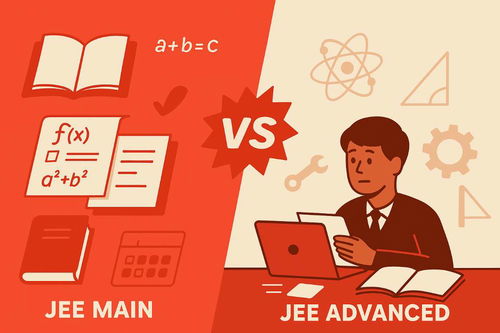
Discover the key differences between JEE Main and JEE Advanced in terms of syllabus, pattern, difficulty, and prep...

Confused about JEE Main qualification rules? This blog gives you a detailed checklist of eligibility criteria,...

Explore this simple, step‑by‑step guide to the JEE Main counselling process. Learn how to register, fill choices,...

Curious about how many times SC students can attempt JEE Main? This complete guide covers JEE Mains attempt rules,...

Want to score 200+ in JEE Main? This practical guide gives you proven tips, subject-wise strategies, mock test...

Wondering how the JEE Main exam is structured? This complete guide breaks down the official JEE Main exam pattern...
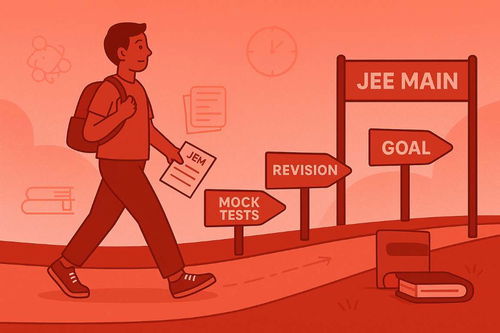
Learn how to crack JEE Main on your first attempt with proven strategies. This guide covers planning, conceptual...
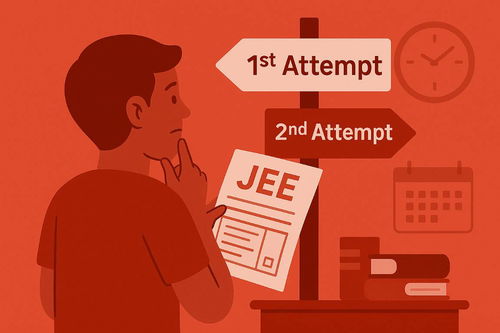
Learn how many JEE Main attempts you can take after Class 12. This guide covers eligibility, attempt limits, subject...

Learn about the JEE Main age limit requirement and key eligibility rules. Understand the attempt policy, Class 12...

Discover the most important topics for the JEE Main exam in Physics, Chemistry, and Mathematics. Learn subject-wise...

Get a subject-wise preparation strategy for JEE Main step-by-step using smart tips and trusted resources from AllRounder.ai.

Looking to score high in JEE Main 2026? Discover expert preparation tips on creating smart study plans, mastering...

Confused about JEE Mains eligibility? This detailed guide explains JEE Mains eligibility criteria including...
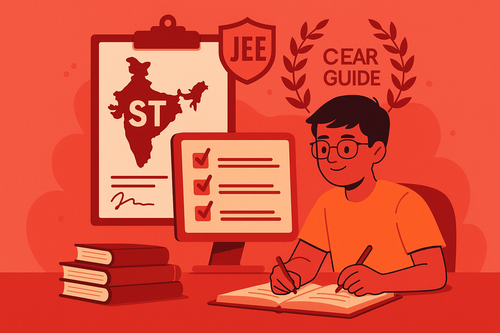
Confused about JEE Main Attempts for ST Category? This detailed guide covers attempt limits, age relaxations,...

Wondering how many times OBC candidates can appear for JEE Mains? This detailed guide explains JEE Main Attempts for...

Dropping a year for JEE Mains? This in-depth strategy guide helps droppers optimise their JEE Main attempts with...

Confused about how many times you can appear for JEE Main? This guide explains the number of JEE attempts, session...
Resources
-
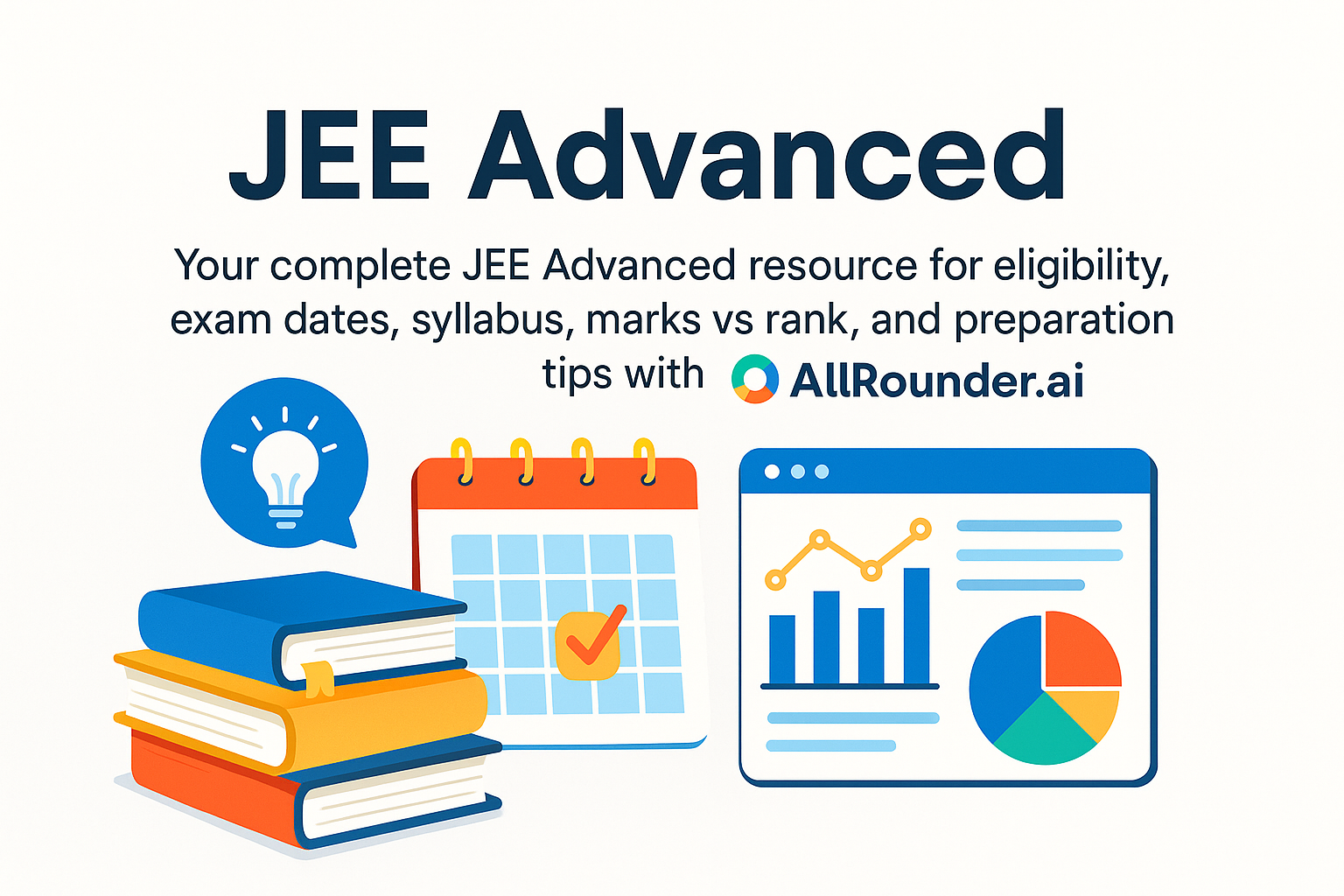
Your complete JEE Advanced resource for eligibility, exam dates, syllabus, marks vs rank, and...
-
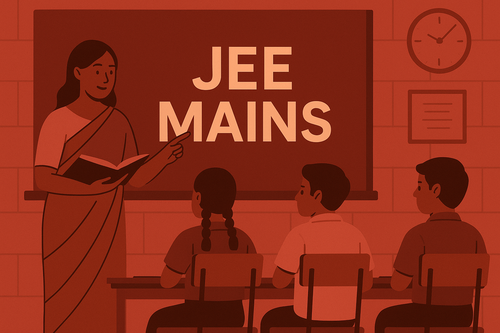
Understand the entire JEE Main process, from application and eligibility rules to the exam...
-

Explore the IB Board – a global curriculum emphasizing holistic, student-centered learning...
-

Learn about CBSE – India’s national school board offering a standardized curriculum, NCERT...
-

Explore everything about the ICSE board – its curriculum, subjects, exam format, and academic...
